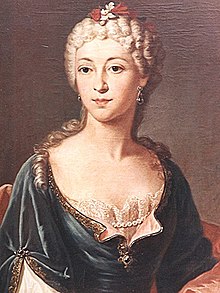Holnstein (noble family)
The Counts of Holnstein from Bavaria are a Bavarian noble family.
history
origin
The ancestor of the family that still exists today is Count Franz Ludwig von Holnstein (1723–1780). It came from the relationship between the Elector and later Emperor Karl Albrecht of Bavaria (1697–1745) and Maria Caroline Charlotte Freiin von Ingenheim (1704–1749), lady-in-waiting of the Electress Therese Kunigunde and sister of the Lieutenant Field Marshal Karl Wilhelm von Ingenheim . As a legitimate natural son, Franz Ludwig was not a member of the Wittelsbach family and was not a member of the Bavarian line of succession, but his father gave him the hereditary title " Count von Holnstein from Bavaria " and a family coat of arms.
The son of Elector Karl Albrecht, born in 1723, lived in the Palais Holnstein in Munich, which was built for him by François de Cuvilliés on behalf of the Elector from 1733 to 1737 . The facade of the building used today by the Archbishop of Munich and Freising is adorned with a depiction of the Count's Holnstein family coat of arms.
development
In 1794, the market town of Schwarzenfeld in Upper Palatinate came into the possession of the Counts of Holnstein, who also owned extensive estates in this area and lived in Schwarzenfeld Castle . A grandson of Franz Ludwig, the landowner and royal treasurer Karl Theodor von Holnstein (1797-1857) married on November 9, 1831 the then 16-year-old Caroline Maximiliana Maria Freiin von Spiering (1815-1859) . She was 18 years younger than him, but relationships between her families had existed for a long time, as the Holnstein estates in the Upper Palatinate bordered directly on the estates of the Barons von Spiering. The couple moved to Munich, where the countess opened many doors at court to her husband's position. The young countess was first noticed by King Ludwig I in 1833 . He finally had Caroline von Holnstein immortalized in the beauty gallery in the Residenz (now in Nymphenburg Palace ).
From 1857, their son Maximilian Karl Theodor (1835–1895) lived at Schwarzenfeld Castle , who as the hereditary Bavarian Imperial Councilor and chief stableman of King Ludwig II had great influence on politics in the Kingdom of Bavaria . As a diplomat, Count Holnstein played an important role in the creation of the Kaiserbrief , with which King Ludwig II formally proposed to the Prussian King Wilhelm I the dignity of the newly founded German Empire on December 3, 1870 . In Schwarzenfeld, Maximilian Karl Theodor von Holnstein had the palace built from 1890 to 1892 in the historicist style. Shortly after completion, he used the castle as a retirement home, and after his death he was buried in a mausoleum in the Schwarzenfeld cemetery. His widow Maximiliane, b. von Gumppenberg (1850–1937), and his descendants lived in Schwarzenfeld Castle for only a few years. From 1907 it remained unused, except for brief leases. Economic and financial hardships forced Countess Maximiliane von Holnstein to sell it to the NS-Volkswohlfahrt Berlin in 1936.
Karoline von Bretzenheim (1768–1786), an illegitimate daughter of Elector Karl Theodor of Palatinate and Bavaria (1724–1799), married Count Maximilian Joseph von Holnstein (1760–1838), governor of the Upper Palatinate , a son of the family founder , Franz Ludwig von Holnstein. The couple had an only son, who died without any offspring, which is why this family line, which goes back to two illegitimate Wittelsbach children, did not continue. Karoline von Holnstein born von Bretzenheim was buried in the Theatinerkirche (Munich) , a traditional burial place of the Wittelsbach family, where an epitaph with the Holnstein-Bretzenheim alliance coat of arms commemorates them.
coat of arms
The family coat of arms of the Counts of Holnstein is a Wittelsbach bastard coat of arms : It shows the shield of the dukes and electors of Bavaria with a bastard thread .
gallery
The Palais Holnstein in Munich
Schwarzenfeld Castle in the Upper Palatinate
Caroline von Holnstein , painting by Joseph Stieler
Maximilian Karl Theodor von Holnstein , Reichsrat and diplomat Ludwig II.
See also
- Prince of Löwenstein-Wertheim , morganatic descendants of Count Ludwig I of Löwenstein (1463–1523) from the Palatinate line of the Wittelsbach family
- Counts of Wartenberg , morganatic descendants of Duke Ferdinand of Bavaria (1550–1608)
- Prince of Bretzenheim , illegitimate descendants of Elector Karl Theodor of Palatinate and Bavaria (1724–1799)
Web links
- Genealogy of the Counts of Holnstein
- Website for the Holnstein mausoleum in Schwarzenfeld / Upper Palatinate







